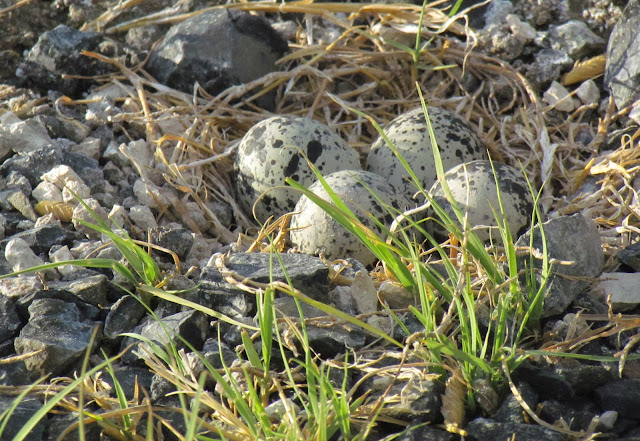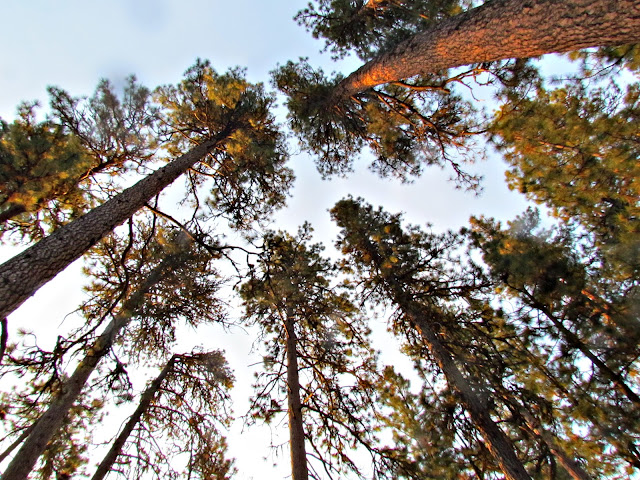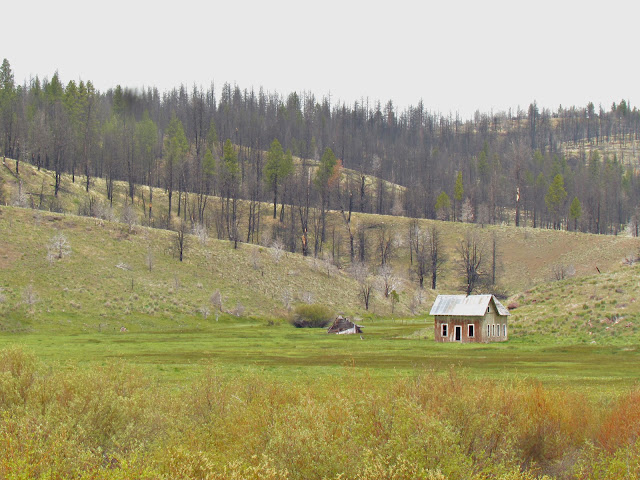I'm now deep into collecting bees and processing them. I still haven't learned the vocabulary of their structures to begin to identify them. They will eventually get to an expert who will do the identifying.
I set up a transect that I will redo every two weeks. We discussed 12 sites but I can't easily get to several of them and I am finding that there are so many bees and flies on each site, that it takes me several hours to process each site. So I think I'm going to do 11 all the time and will take my bee collecting supplies and GPS and do one-time collecting when I'm off camping. (
I'm about to set off camping today.)
Once I drive in a stake and take a set it up as a way point so I have the coordinates of that point, I put out 14 little cups, full of soapy water, about 5 meters apart. I also have to label 2 each of 3 kinds of shrubs and write up the data on where they are in their life cycle, i.e. new leaves, buds, blooms, spent blooms, etc. Then I come back in about 24 hours and collect everything from all the cups into one sample. I rinse the sample with clean water, then put it into a little bag and cover the sample with ethyl alcohol. . I bring them home and store them in the freezer until I'm ready to pin them. If I can find bees on flowers, I tray to catch several of them, trying for different looking ones so I get samples of different species.
When I'm ready to process the bees, I strain the bees out of the ethyl alcohol, and save it. Then I wash the bees in soapy water in a closed container which I have to shake to get the pollen of the bees. Then I pour them back into a net and rinse them thoroughly. I shake off as much water as I can and then dip the bees and net into a bowl of ethyl alcohol.
The bees are then drained on a paper towel and patted with another one. After sorting out the flies and butterflies/moths, I dry them with a hair dryer and finally pin them. Since most of the bees are less than 1/4 inch long, this is the hardest part.
I also have a butterfly net and kill bottles to use to capture bees and kill them that way. When they drown in the soapy water, they pull in their mouth parts, which are required for ID in some cases. I'm also trying to get pictures of live bees. Eventually we plan to collect and dry plants bees are using, then glue some of our bees on the flowers. We'll also have pictures of bees. in our display of pollinators. I plan to also pin some butterflies to use in our display.
 |
| This is our most common bumble bee.It has a central orange stripe. I've found it all across Malheur NWR |
Next, I dump the sample onto a paper towel, gently spread theinsects out, and remove
flies and butterflies. Flies have two wings and bees have 4. This gets
hard to see when the bees/flies are less than one-eigth of an inch long.
I'm awed by how many bees I'm getting from some sites. I have between
50 and 100 from a couple of sites and the season is just starting.
My last step is to pour the bees into a container and dry them with a hair dryer for about 5 minutes. Then I'm ready to pin them and try to pull out all their legs and wings so they can be seen. I have to finish this last step the following day.
 |
| Finished bees from three sites. I'm getting 4 to over 120 from a site. |
I
haven't pinned all the bees from any sites because I haven't had a
microscope or lens and can't distinguish tiny bees from flies. I can
put these bees back into a bag of ethanol and keep them for later.
 |
| This bumble bee is all yellow. I've only collected two specimens |
 |
| This bee has a gorgeous rusty orange on it's thorax. It's about the size of a honey bee. |
I expect bees to be fuzzy but many of my bees are metallic and blue or green. One is the color of my favorite childhood dress, it is emerald green with turquoise and bright blue highlights.
 |
| This bee is tiny and metallic blue |
 |
| This bee is about the size of a honey bee and has a metallic abdomen |
 |
| This bee has metallic colors from emerald to blue |
 |
| This is my largest species of metallic green bees - skinny but almost as long as a honey bee. |
Next, I dump the sample onto a paper towel, gently flatten it out, and remove flies and butterflies. Flies have two wings and bees have 4. This gets hard to see when the bees/flies are less than one-eigth of an inch long. I'm awed by how many bees I'm getting from some sites. I have between 50 and 100 from a couple of sites and the season is just starting. I haven't pinned all the bees from any sites because I haven't had a microscope or lens and can't distinguish tiny bees from flies. I can put these bees back into a bag of ethanol and keep them for later.
This is the most fascinating job I've gotten to do. I'm about to go camping and I plan to take along my bee catching supplies and my GPS and collect a sample of bees in Malheur National Forest.
And yesterday, I got a digital microscope with a camera lens. I'll be able to capture close-up pictures of the mouth parts, eyes, etc, of the bees. I'm going to learn how to use it next week. I also have a system of camera mount and lights that I'm going to use to take pictures of some of my pinned bees. So little time and so many bees.

















































